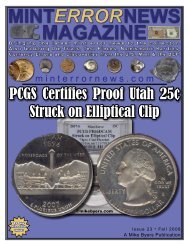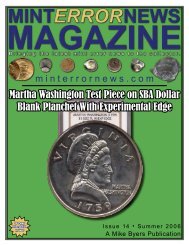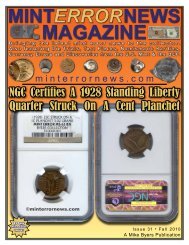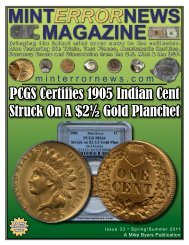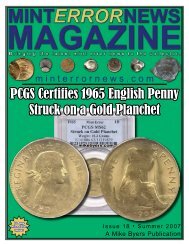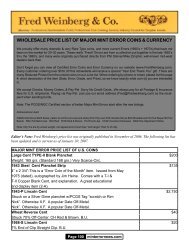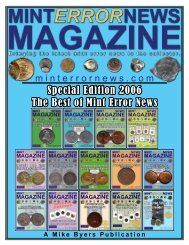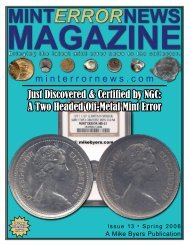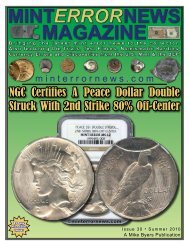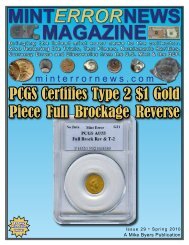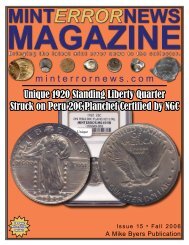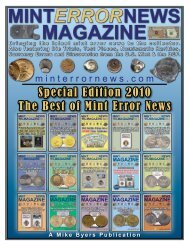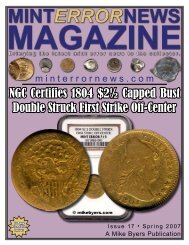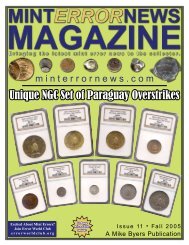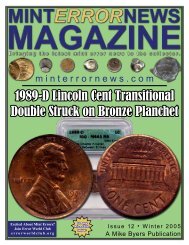Issue 1 - Mint Error News Magazine
Issue 1 - Mint Error News Magazine
Issue 1 - Mint Error News Magazine
You also want an ePaper? Increase the reach of your titles
YUMPU automatically turns print PDFs into web optimized ePapers that Google loves.
It further went on to state, “All persons<br />
are hereby required to deliver on<br />
or before May 1, 1933, to a Federal<br />
Reserve bank or a branch or agency<br />
thereof or to any member bank of the<br />
Federal Reserve System all gold coin,<br />
gold bullion, and gold certificates<br />
now owned by them or coming into<br />
their ownership on or before April<br />
28, 1933”. In other words, the government<br />
recalled all gold coinage and<br />
currency payable in gold coin from<br />
the banks and made it illegal for any<br />
U.S. citizen to hold gold in the form<br />
of coins or bullion. This act was further<br />
given teeth when you remember<br />
that this came in the midst of the<br />
worst depression in U.S. history when<br />
the common man barely had enough<br />
money to supply food, clothing and<br />
shelter for his family, much less being<br />
able to hoard gold. Were it not<br />
for farsighted wealthy numismatists<br />
that violated this law, we would not<br />
have the beautiful gold coins that we<br />
admire today. Once again, the specific<br />
dates/mints that were melted is<br />
unknown.<br />
The Great Silver Melt (1960<br />
– 1965)<br />
For quite some time the U.S.<br />
Treasury had been a net buyer of silver,<br />
in part to keep the silver markets<br />
settled and for the manufacture of<br />
coinage. By 1960, it had become a net<br />
seller as silver prices began to rise.<br />
The Treasury sold 22 million ounces<br />
of silver bullion in 1960, and used<br />
another 46 million ounces in coinage.<br />
The next year the Treasury had to sell<br />
63 million ounces of bullion to settle<br />
the silver markets and use another 56<br />
million ounces to replace silver coins<br />
that had been taken out of circulation<br />
by investors speculating in silver.<br />
The Treasury quickly realized that<br />
it would run out of silver for use in<br />
coinage and as backing against silver<br />
certificates unless it took drastic<br />
measures. It thus began phasing silver<br />
out of currency. In 1961, the Treasury<br />
ordered $5 and $10 silver certificates<br />
out of circulation, freeing silver reserves<br />
held against these bills. In November<br />
of 1961 the government also<br />
suspended silver bullion sales by the<br />
Treasury at the formerly fixed price<br />
of 91 cents.<br />
Without the active intervention<br />
of the U.S. Treasury on its behalf,<br />
the price of silver quickly rose.<br />
By 1963, silver prices reached $1.29,<br />
which was equal to the value of the<br />
silver in our coins. At $1.38/oz it became<br />
profitable to recycle coinage for<br />
its silver content.<br />
Between 1960 and 1965 the<br />
Treasury sold silver to keep the price<br />
stable Over the six years between<br />
1960 and 1965, the Treasury used 814<br />
million ounces of silver in coinage.<br />
The silver used in coinage during this<br />
time quickly found its way into the<br />
hands of investors. Government steps<br />
to remove silver from the currency<br />
had led investors to conclude that the<br />
price of silver would rise sharply once<br />
the Treasury no longer was supplying<br />
the market with such large volumes of<br />
the metal and thus the investor run on<br />
silver had begun. Coin melt rose from<br />
10 million ounces in 1960 to 30 million<br />
ounces in 1965.<br />
The Hunt Brothers (1970’s)<br />
As if our silver coinage had<br />
not been beaten up enough by this<br />
point, along came the Hunt Brothers<br />
of Texas. In 1973, the Hunt family of<br />
Texas was quite possibly the richest<br />
family in America and, as a hedge<br />
against inflation, decided to buy silver<br />
bullion. Remember, it became illegal<br />
to own gold in 1933 so the Hunts began<br />
to buy silver in enormous quantity.<br />
Page 27 minterrornews.com<br />
By 1979 Nelson Bunker Hunt and<br />
William Herbert Hunt formed a silver<br />
pool of more than 200 million ounces<br />
of silver, equivalent to half the world’s<br />
deliverable supply.<br />
The Hunts started buying silver back<br />
in 1973 when the price was in the<br />
$1.95 / ounce range. By 19’79, the<br />
price had climbed to around $5. As of<br />
early 1980 the price had skyrocketed<br />
up to the $50 range, peaking at $54.<br />
Very quickly, a combination of<br />
changed trading rules on the New<br />
York Metals Market (COMEX) and<br />
the intervention of the Federal Reserve<br />
put an end to the game. The<br />
price began to slide, culminating in<br />
a 50% one-day decline on March 27,<br />
1980 as the price plummeted from<br />
$21.62 to $10.80.<br />
What this meant for U.S. silver coinage<br />
was that all, or most of the silver<br />
coinage that had escaped the Treasury’s<br />
grasp in the early 1960’s fell<br />
into the great melting pot as the price<br />
of a common silver dime (numismatic<br />
value $.20) soared to $2.50 and more.<br />
“Common” Morgan and Peace dollars<br />
died as their melt price exceeded<br />
$25 along with common Franklin<br />
And Walking Liberty Half dollars<br />
whose melt value exceeded $12.00. I<br />
personally viewed the melting stock<br />
of some buyers, which contained not<br />
only silver dollars but also Barber<br />
coinage and 3¢ silvers. BU rolls and<br />
individual coins were turned in to be<br />
melted indiscriminately.<br />
To answer the question that I posed<br />
earlier… Where are all the coins…<br />
the answer is GONE for the most<br />
part. Except for those that survived<br />
in cookie jars, collector’s albums and<br />
investors inventory. It is a wonder<br />
that some dates/mints haven’t disappeared<br />
completely during all of this<br />
mayhem.



